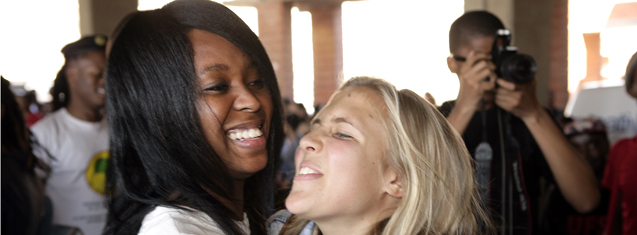
Ms Mosa Leteane and Ms Louzanne Coetzee
Photo: Johan Roux
While campuses across South Africa regularly report falling voter turnout in campus elections of student representatives, the University of the Free State, in its recently completed SRC elections, registered record levels of support across our campuses with a total voter turnout of 44%. At the Bloemfontein Campus 34,4% of students voted (5052 votes) and 53,3% (1583 votes) at the Qwaqwa Campus.
Also, for the first time under the new SRC constitution, students elected a woman to lead the student body – Ms Mosa Leteane was elected as President. Another first was the election of a blind woman to the SRC – Ms Louzanne Coetzee. She will be responsible for student accessibility of our Bloemfontein SRC. This marks a victory for women in student governance.
Mr Tulasizwe Sithole was elected as the President of the SRC at our Qwaqwa Campus.
The election of Ms Leteane as President underscores the progress achieved for gender equality with near half of her SRC consisting of women (48%).
These successes are all the more significant, since this is the 4th year of elections under newly adopted SRC constitutions that allow for broader participation of diverse student constituencies in student governance.
This means that the crucial 3-year mark to test a new approach and method in governance and elections was not only successfully reached, but also in its 4th year shows the constitution as one that sustains its impact to deepen democracy and citizenship among our 30,000-strong student body.
“The results of the SRC elections across campuses show that our students are not only ready to lead our campus communities on issues relating to justice, freedom and democracy beyond our societal legacies of race and gender, but do so also for the student movement nationally. We’re immensely proud of our students, who show courage and resilience to choose leaders not for expediency, but for significance, and to lead not for some, but for all”, the Dean of Student Affairs, Rudi Buys, said.
The Qwaqwa SRC was installed on 2 September 2014, while the Bloemfontein SRC will be installed on 5 September. The Central SRC will be established on 14 September by joint sitting of the two SRCs.
The SRC members 2014/15 at the Bloemfontein and Qwaqwa Campuses are as follows:
Bloemfontein Elective portfolios:
President: Ms Mosa Leteane
Vice Pres: Mr Waldo Staude
Secretary: Ms Dineo Motaung
Treasurer: Ms Maphenye Maditsi
Arts & Culture: Mr Stefan van der Westhuizen
Accessibility & Student Support: Ms Louzanne Coetzee
First Generation Students: Ms Mpho Khati
Media, Marketing & Liaison: Ms Lethabo Maebana
Legal & Constitutional Affairs: Mr Lindokuhle Ntuli
Sport: Ms Dominique de Gouveia
Student development & Environmental Affairs: Mr Victor Ngubeni
Transformation: Mr Tumelo Rapitsi
Bloemfontein Ex officio Portfolios
Dialogue & Ex officio: Associations Student Council: Mr Piet Thibane
Academic Affairs & Ex officio: Academic Affairs Student Council: Mr Jonathan Ruwanika
Residence Affairs & Ex officio: Campus Residences Student Council: Ms Melissa Taljaard
City student Affairs & Ex officio: Commuter Student Council: Ms Kerry-Beth Berry
Post graduate Affairs & Ex officio: Post Graduate Student Council: Ms Masabata Mokgesi
International Affairs & Ex officio: International Student Council: Mr Makate Maieane
Student Media Affairs & Ex officio: Student Media Council: Mr Samuel Phuti
RAG Community Service & Ex officio: RAG Fundraising Council: Mr Johan du Plessis
RAG Community Service & Ex officio: RAG Community Service Council: Mr Manfred Titus
Qwaqwa Elective portfolios:
President General: Mr Thulasizwe Sithole
Deputy President: Ms Zethu Mhlongo
Secretary General: Mr Vukani Ntuli
Treasurer General: Mr Langelihle Mbense
Media & Publicity: Ms Nongcebo Qwabe
Politics & Transformation: Ms Nkosiphile Zwane
Qwaqwa Ex officio Portfolios
Student Development & Environmental Affairs: Mr Ndumiso Memela
Academic Affairs: Mr Simon Mofekeng
Arts & Cultural Affairs: Ms Samkelo Mtshali
Off-Campus Students: Mr Khanyisani Mbatha
RAG, Community Service & Dialogue: Mr Njabulo Mabaso
Religious Affairs: Mr Mfundo Nxumalo
Residence & Catering Affairs: Ms Ntombifuthi Radebe
Sports Council: Mr Luvuno